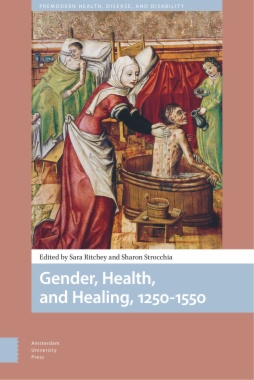This path-breaking collection offers an integrative model for understanding health and healing in Europe and the Mediterranean from 1250 to 1550. By foregrounding gender as an organizing principle of healthcare, the contributors challenge traditional binaries that ahistorically separate care from cure, medicine from religion, and domestic healing from fee-for-service medical exchanges. The essays collected here illuminate previously hidden and undervalued forms of healthcare and varieties of body knowledge produced and transmitted outside the traditional settings of university, guild, and academy. They draw on non-traditional sources -- vernacular regimens, oral communications, religious and legal sources, images and objects -- to reveal additional locations for producing body knowledge in households, religious communities, hospices, and public markets. Emphasizing cross-confessional and multilinguistic exchange, the essays also reveal the multiple pathways for knowledge transfer in these centuries. Gender, Health, and Healing, 1250-1550 provides a synoptic view of how gender and cross-cultural exchange shaped medical theory and practice in later medieval and Renaissance societies.
- Cover
- Table of Contents
- Acknowledgments
- Abbreviations
- Introduction
- Gendering Medieval Health and Healing: New Sources, New Perspectives
- Sara Ritchey and Sharon Strocchia
- Part 1: Sources of Religious Healing
- 1. Caring by the Hours
- The Psalter as a Gendered Healthcare Technology
- 2. Female Saints as Agents of Female Healing
- Gendered Practices and Patronage in the Cult of St. Cunigunde
- Part 2: Producing and Transmitting Medical Knowledge
- 3. Blood, Milk, and Breastbleeding
- The Humoral Economy of Women’s Bodies in Medieval Medicine
- Montserrat Cabré and Fernando Salmón
- 4. Care of the Breast in the Late Middle Ages
- The Tractatus de passionibus mamillarum
- 5. Household Medicine for a Renaissance Court
- Caterina Sforza’s Ricettario Reconsidered
- Sheila Barker and Sharon Strocchia
- 6. Understanding/Controlling the Female Body in Ten Recipes
- Print and the Dissemination of Medical Knowledge about Women in the Early Sixteenth Century
- Part 3: Infirmity and Care
- 7. Ubi non est mulier, ingemiscit egens?
- Gendered Perceptions of Care from the Thirteenth to Sixteenth Centuries
- 8. Domestic Care in the Sixteenth Century
- Expectations, Experiences, and Practices from a Gendered Perspective
- 9. Bathtubs as a Healing Approach in Fifteenth-Century Ottoman Medicine
- Part 4: (In)fertility and Reproduction
- 10. Gender, Old Age, and the Infertile Body in Medieval Medicine
- 11. Gender Segregation and the Possibility of Arabo-Galenic Gynecological Practice in the Medieval Islamic World
- Afterword
- Healing Women and Women Healers
- Contributors
- Index
- List of Figures and Tables
- Figures
- Figure 1.1 Hours of Nativity of the Virgin, at Matins showing birth of the Virgin with midwife handing baby to Joachim and midwife bathing the baby
- Figure 1.2 Full-page miniature featuring Christ washing feet, Last Supper, Gethsemene, Crucifixion; exterior roundels depict saints Dominic, Leonard, Martin, Bartholomew, Denis, and Lawrence
- Figure 2.1 Fragment from the catalogue of relics of Bamberg Cathedral showing one of the mantels of Cunigunde and her tunic with the belt
- Figure 2.2 Last page of the printed legend of Henry and Cunigunde with the measurements of Cunigunde’s body
- Figure 3.1 Avicenna as an Eastern master demonstrating the breast to a male student
- Figure 4.1 An original recipe from the Tractatus de passionibus mamillarum
- Figure 5.1 Front cover of Sforza’s recipe book marked with initial ‘B’
- Figure 5.2 Index page in B volume showing taxonomy of recipes
- Figure 8.1 ‘Die Jnstrumenta soltu han/ Ee dich deß schnidts solt vnderstan’ (‘You must have these instruments before performing herniotomy’)
- Figure 8.2 The surgeon applies a drainage while a woman provides the patient with a potion
- Figure 8.3 The surgeon is instructed to bathe the patient and help him into the bed, which meanwhile has to be prepared
- Figure 8.4 The surgeon applies the warm, moist wound dressing (Beefetzen)
- Tables
- Table 4.1 Transcription of an original recipe from the Tractatus de passionibus mamillarum
- Table 6.1 Recipe ingredients compared
- Table 9.1 Conditions treated by bathtub therapies in al-Shirwānī, Rawḍat al-‘iṭr, chapter 33
- Table 9.2 Plants used in al-Shirwānī’s remedies, Rawḍat al-‘iṭr, chapter 33

